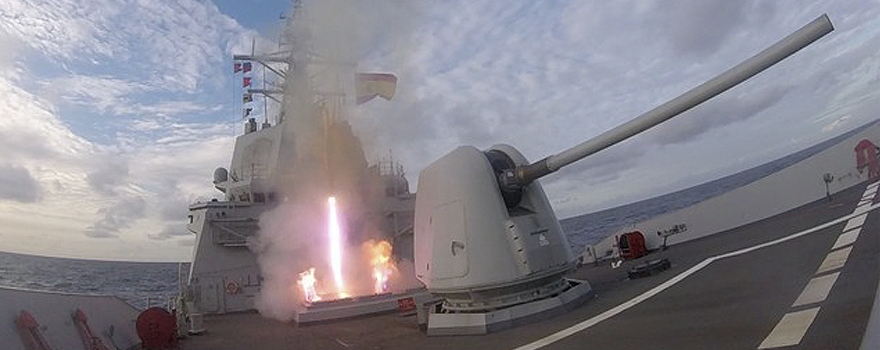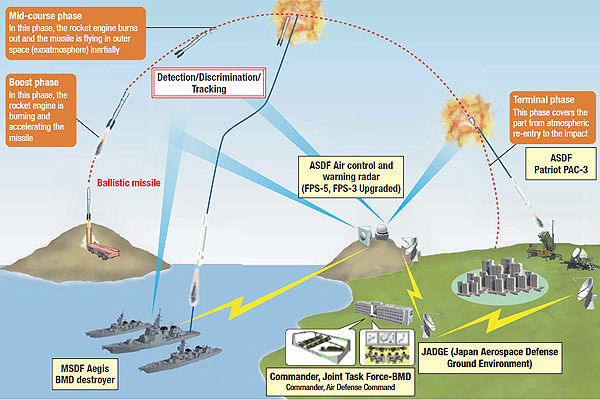Ruta de navegación
Blogs
Entries with label aegis .
The Trump Administration endorses fill in in the European theater the deployment of the Aegis system put in place by Obama.
The main defense deployment in Europe is the Ballistic Missile Defense System, a NATO capability that has been completed following the so-called European Phased Adaptive approach (EPAA). Put in place during the Obama Administration, the Trump Administration has just ratified it in its Missile Defense Review. The withdrawal of the Intermediate-Range Nuclear Weapons Treaty (INF Treaty), which bound the United States and Russia, puts the missile defense system on the diary of European priorities.

▲ Launching of the ESSM missile from the Spanish frigate Álvaro de Bazán [Armada].
article / Martín Biera
In the pre-industrial era, battles were largely fought face to face, but in the technological era the line of defense can be placed at a great distance. Thus, in Europe the main defense deployment is the Ballistic Missile Defense System. This is a NATO capability that integrates the Aegis naval system and the Patriot land-based system, produced by Lockeed Martin and Raytheon, respectively, which can be used in the same scenario.
Its deployment in Europe was proposed by the Obama Administration in 2009 in what is known as approach European Phased Adaptive Approach (EPAA). This program aims to progressively develop anti-ballistic capabilities that will assist in the defense of NATO allies in the European theater.
The Missile Defense Review document, released by the Pentagon in January, reiterates the U.S. commitment to the planned program. "The United States is committed to fill in the deployment of the EPAA," the text states.
If in other respects, the Trump Administration has shown signs of a certain withdrawal of its military deployment in the world, on this point it maintains its technological and operational contribution so that NATO can sustain in the European theater its missile defense architecture. "The United States will strengthen regional missile defense capabilities and cooperative relations with its allies and partners," the document adds. It calls, however, as it has already done in relation to overall contributions to NATO by its member states, for "additional allied investment in missile defense, including development and joint production, to better share the common defense burden."
Phased implementation
The EPAA is planned in four phases, from agreement with the Polish Foreign Ministry and the administration of former President Obama in the strategy of implementing advanced anti-ballistic missile systems in Europe.
The first phase, implemented in 2011, included the deployment in the Mediterranean Sea of ships equipped with the Aegis Anti-Ballistic Missile System (SAMB) and SM-3 IA missile launchers capable of intercepting short and medium range missiles (up to 3,000 kilometers). The frigate Álvaro de Bazán is equipped with the Aegis combat system (the Spanish Navy is the only one in Europe, besides the Norwegian Navy, integrated in this system). It also included the installation of a radar device located in Turkey, the AN/TPY-2, which operates in the X-band (microwave section of the electromagnetic spectrum, used by communication satellites).
The second phase was implemented in 2015. It additionally covers the deployment in Romania of a surface-to-air missile launch system subject IB-SM-3 capable of countering short- and medium-range missiles of more than 500 kilometers effective range, and the deployment of the four ships with the Aegis AMB capability. AN/TPY-2 radar capabilities were enhanced with an additional network of sensors.
The third phase, in 2018, consisted of the deployment in Poland of a ground-based subject II-SMA missile launcher capable of combating intermediate-range missiles (IRBM up to 5,500 km). The launchers are located at the Redzikowo base.
The last phase will take place in 2020 and will allow U.S. allies to improve anti-missile systems against medium- and long-range missiles and ICMBs, culminating in the implementation of SM-3 Block IIB systems that will also include a command and control system.
Thus, the SAMB Aegis system includes the capabilities deployed on the two permanent instructions (in Poland and Romania) and on board four Aegis BMD ships (in the Mediterranean Sea, based in Rota), as well as a radar operating in the X-band and a network of sensors, which makes it possible to defend the European continent against short, medium and long-range missiles.
Operation
First, infrared and communication satellites provide early warning. When a ballistic missile is launched, it is detected by the infrared satellite; the information it picks up is sent to a communications satellite, which notifies a NATO headquarters, where it is analyzed. In the case of Europe, this information is sent to the Ramstein base in Germany, where it is confirmed whether the projectile is a threat. It is then communicated to all appropriate forces, both commanders and defense systems.
When the engine finishes burning the fuel on the missile's upward trajectory, the infrared satellite can no longer detect it, so long-range sensors, such as the AN/TPY-2 system or the Smart-L Radar naval system located in Holland, are used. These sensors detect and continue analyzing the missile so that it can be intercepted. The process also integrates the Aegis system, which consists of AN/SPY-1 radars capable of tracking more than 100 objects. Together, these systems perform a more detailed analysis of the tracking and possible consequences of a ballistic missile.
All systems, on land, at sea and in the air, have the ability to share and update instantly share information. The core topic of this system is the ability to destroy the missile outside the atmosphere, largely thanks to the Aegis system, although systems such as THAAD can also provide additional capabilities. The Aegis system provides cover for missiles that have passed through the atmosphere; in the event that a missile re-enters the atmosphere, the Patriot system, which is used by France, Germany, Spain and other countries, comes into operation.
Patriot System
Following Poland's decision to allocate a higher percentage of GDP to defense, the country is expected to increase its military capacity. On March 28, Poland signed a $4.75 billion agreement with the United States for the purchase of the Patriot missile system. Its manufacturer, Raytheon, undertook to build in Poland parts core topic of the system, creating "new high-tech jobs", as required by Polish law.
Poland will join fifteen other countries in Europe, the Pacific and the Middle East that share and operate with this system This agreement comes after Poland signed a ten-year agreement with Raytheon to facilitate the introduction of Patriot missiles among the country's defensive capabilities. In mid-2018 Warsaw ran into some complications in acquiring the Patriots, as the civil service examination put up roadblocks to the approval of the purchase. Finally, the Polish government and Raytheon signed the project at the agreed value of €4.75 billion.
In November 2017 Romania and Sweden also showed interest in purchasing Patriots. In the case of the Middle East, the countries that mainly use this system are Israel and Qatar, although the Pentagon has expressed its desire to withdraw its batteries from the region.
|
outline of the Ballistic Missile Defense System [Ministry of Defense of Japan]. |
Russian alternative
The Polish purchase of Patriot missiles was criticized by Russia. Foreign Ministry spokeswoman Maria Zakharova condemned the "progressive militarization" of that country. Moscow sees such "militarization" moves as an element of destabilization of the military and political apparatus in Europe and a threat to Russia.
The Kremlin criticized the deployment of the Patriot missile system batteries as a violation of the arms control treaty signed in 1987 between Mikhail Gorbachev and Ronald Reagan. This Intermediate-Range Nuclear Forces Treaty (INF Treaty) is about to be abandoned by the United States on the grounds that Russia has been violating it with some of its missile developments.
In response to degree program for advances in surface-to-air missile technology, the Russian arms industry developed the S-400 Triumf, which NATO designates as the SA-21 Growler. The S-400 system is a mobile defense system, which offers greater versatility and firepower. Countries such as Saudi Arabia, Turkey and India have shown interest in purchasing this system despite US sanctions. The fact that major users and customers of U.S. weapons are interested in competing companies poses a problem for the U.S. military industry. The S-400 is capable of reaching a flight ceiling of 185 kilometers and an effective range distance of 120, 250 and 400 kilometers depending on the missile employee. By 2020 the Russian Army will have a new generation missile system, the S-500, a more advanced and more powerful version than the current ones.
Deterrence
"Invincibility is in oneself, vulnerability is in the adversary.
Invincibility is a matter of defense, vulnerability is a matter of attack. As long as you have not observed vulnerabilities in the order of battle of the adversaries, hide your own attack training , and prepare to be invincible, in order to preserve yourself. When adversaries have vulnerable orders of battle, it is time to go out and attack them." The Art of War, Sun Tzu.
Both NATO and Russian systems clearly have a deterrent facet. Every military operation has a relevant diplomatic, political and interest role. After the Russian annexation of Crimea and the Vostok 2018 and Trident Juncture maneuvers, missile defense systems appear to be the future of European and international security. In recent years, in a context of militarization of space by the world's military powers, a update of missile systems is underway that not only makes it possible to reach farther but also to be more precise. From agreement with the defense strategy of both the European and the Atlantic organization has led its partners to have better capabilities than their competitors to ensure the security of States. Consequently, a progressive but effective modernization of anti-missile systems.
In recent years, in the face of Russia's and China's advancement and modernization of weapons, the United States has seen the need to develop space-based systems capable of shooting down missiles, with some resemblance to the cancelled Pebbles Program. The Pebbles program sought to put into orbit autonomous systems capable of intercepting any missile launched by U.S. competitors. These systems would provide the U.S. and its allies with a capability to counter almost any subject projectile, giving them an unprecedented advantage. The employment of anti-missile systems strengthens the bond between the United States and its allies, thus enabling more effective defense and cooperation as a necessary relationship.
On the other hand, there are analysts who can see this escalation in the purchase and use of AMB systems as a new cold war, at least on a smaller scale, mainly because it is taking place in Europe and in new facets such as the economic one, manifested through the influence that arms companies exert over national governments.

